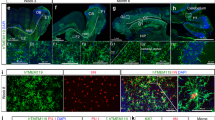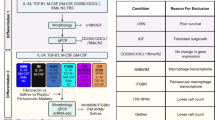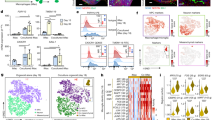Abstract
Microglia, the resident immune cells of the brain, are difficult to obtain in high numbers and purity using currently available methods; to date, microglia for experimental research are mainly isolated from the brain or from mixed glial cultures. In this paper, we describe a basic protocol for the in vitro differentiation of mouse embryonic stem (ES) cells into microglial precursor cells. Microglia are obtained by a protocol consisting of five stages: (i) cultivation of ES cells, (ii) formation and differentiation of embryoid bodies, (iii) differentiation into neuroectodermal lineage and isolation of myeloid precursor cells, (iv) differentiation into microglial precursor cells and (v) cultivation of ES cell-derived microglial precursors (ESdMs). The protocol can be completed in 60 d and results in stably proliferating ESdM lines, which show inducible transcription of inflammatory genes and cell marker expression comparable with primary microglia. Furthermore, ESdMs are capable of chemokine-directed migration and phagocytosis, which are major functional features of microglia.
This is a preview of subscription content, access via your institution
Access options
Subscribe to this journal
Receive 12 print issues and online access
$259.00 per year
only $21.58 per issue
Buy this article
- Purchase on Springer Link
- Instant access to full article PDF
Prices may be subject to local taxes which are calculated during checkout




Similar content being viewed by others
References
Ransohoff, R.M. & Perry, V.H. Microglial physiology: unique stimuli, specialized responses. Annu. Rev. Immunol. 27, 119–145 (2009).
Chan, W.Y., Kohsaka, S. & Rezaie, P. The origin and cell lineage of microglia: new concepts. Brain. Res. Rev. 53, 344–354 (2007).
Ajami, B., Bennett, J.L., Krieger, C., Tetzlaff, W. & Rossi, F.M. Local self-renewal can sustain CNS microglia maintenance and function throughout adult life. Nat. Neurosci. 10, 1538–1543 (2007).
Hanisch, U.K. & Kettenmann, H. Microglia: active sensor and versatile effector cells in the normal and pathologic brain. Nat. Neurosci. 10, 1387–1394 (2007).
Block, M.L., Zecca, L. & Hong, J.S. Microglia-mediated neurotoxicity: uncovering the molecular mechanisms. Nat. Rev. Neurosci. 8, 57–69 (2007).
Havenith, C.E., Askew, D. & Walker, W.S. Mouse resident microglia: isolation and characterization of immunoregulatory properties with naive CD4+ and CD8+ T-cells. Glia 22 (4): 348–359 (1998).
Ford, A.L., Goodsall, A.L., Hickey, W.F. & Sedgwick, J.D. Normal adult ramified microglia separated from other central nervous system macrophages by flow cytometric sorting. Phenotypic differences defined and direct ex vivo antigen presentation to myelin basic protein-reactive CD4+ T cells compared. J. Immunol. 154, 4309–4321 (1995).
Blasi, E., Barluzzi, R., Bocchini, V., Mazzolla, R. & Bistoni, F. Immortalization of murine microglial cells by a v-raf/v-myc carrying retrovirus. J. Neuroimmunol. 27, 229–237 (1990).
Bocchini, V. et al. .An immortalized cell line expresses properties of activated microglial cells. J. Neurosci. Res. 31, 616–621 (1992).
Tsuchiya, T. et al. Characterization of microglia induced from mouse embryonic stem cells and their migration into the brain parenchyma. J. Neuroimmunol. 160, 210–218 (2005).
Napoli, I., Kierdorf, K. & Neumann, H. Microglial precursors derived from mouse embryonic stem cells. Glia 57, 1660–1671 (2009).
Lee, S.H., Lumelsky, N., Studer, L., Auerbach, J.M. & McKay, R.D. Efficient generation of midbrain and hindbrain neurons from mouse embryonic stem cells. Nat. Biotechnol. 18, 675–679 (2000).
Steinkamp, J.A., Wilson, J.S., Saunders, G.C. & Stewart, C.C. Phagocytosis: flow cytometric quantitation with fluorescent microspheres. Science 215 (4528): 64–66 (1982).
Lenerz, V. et al. Regenerative therapy of experimental autoimmune encephalomyelitis by neurotrophin-3 transduced ES cell derived microglial cells. Glia 57, S92 (2009).
Stein, M., Keshav, S., Harris, N. & Gordon, S. Interleukin 4 potently enhances murine macrophage mannose receptor activity: a marker of alternative immunologic macrophage activation. J. Exp. Med. 176, 287–292 (1992).
Goerdt, S. et al. Alternative versus classical activation of macrophages. Pathobiology 67, 222–226 (1999).
Rae, F. et al. Characterisation and trophic functions of murine embryonic macrophages based upon the use of a Csf1r-EGFP transgene reporter. Dev. Biol. 308, 232–246 (2007).
Torres, K., Torres, R. & Kuhn, R. Laboratory Protocols for Conditional Gene Targeting (Oxford University Press, Oxford, 1997).
Acknowledgements
The Neural Regeneration Group at the University of Bonn Life & Brain Center is supported by the Hertie Foundation, the Walter und Ilse Rose Foundation, the Deutsche Forschungsgemeinschaft (FOR1336, KFO177, SFB704) and the EU (LSHM-CT-2005-018637). We thank J. Schumacher and R. Hass for excellent technical support of cultures and molecular biology.
Author information
Authors and Affiliations
Contributions
C.B. and H.N. conceived and designed the experiments. C.B. performed generation of ESdMs and did most of the characterization of the cells by immunocytochemistry, flow cytometry and qRT-PCR. K.R. carried out the phagocytosis assay and parts of the characterization by flow cytometry. B.L. defined the purity of the cell population and analyzed the migratory capacity of the cells. C.B., K.R., B.L. and H.N. wrote the paper. I.N. participated in the establishment of the generation protocol of ESdMs from ES cells and corrected the paper.
Corresponding author
Ethics declarations
Competing interests
The authors declare no competing financial interests.
Rights and permissions
About this article
Cite this article
Beutner, C., Roy, K., Linnartz, B. et al. Generation of microglial cells from mouse embryonic stem cells. Nat Protoc 5, 1481–1494 (2010). https://doi.org/10.1038/nprot.2010.90
Published:
Issue Date:
DOI: https://doi.org/10.1038/nprot.2010.90
This article is cited by
-
Microglia-containing human brain organoids for the study of brain development and pathology
Molecular Psychiatry (2023)
-
Neuroimmunomodulatory properties of polysialic acid
Glycoconjugate Journal (2023)
-
Evolving Models and Tools for Microglial Studies in the Central Nervous System
Neuroscience Bulletin (2021)
-
Analogous modulation of inflammatory responses by the endocannabinoid system in periodontal ligament cells and microglia
Head & Face Medicine (2020)
-
Microglia: A Central Player in Depression
Current Medical Science (2020)
Comments
By submitting a comment you agree to abide by our Terms and Community Guidelines. If you find something abusive or that does not comply with our terms or guidelines please flag it as inappropriate.



